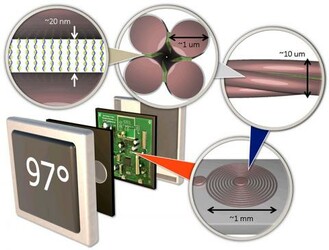Research at Draper and Harvard Could Help Enable IOT
CAMBRIDGE, MA – The Internet of Things (IOT) may generate more than $14 trillion in economic activity by 2025, with examples including vehicles communicating with embedded monitors alongside roadways to better route traffic, and home appliances connected to the smart grid to improve efficiency and reliability. However, the IOT growth expansion depends on sufficient frequency spectrum capacity to connect the assorted devices. Many in industry believe the Federal Communications Commission may have to make significant policy changes to enable the needed connections while avoiding signal interference.
Researchers at Draper and Harvard University are developing a new approach to assembling nanoscale hardware that could overcome this challenge by enabling devices to generate and receive purer signals to reduce interference with other nearby transmissions. This could free up spectrum by reducing the need for space between frequencies that the FCC assigns to different users, explained Draper’s Amy Duwel, technical director for the NanoLitz project.
The Defense Advanced Research Projects Agency (DARPA) and the U.S. Air Force Research Laboratory are funding the NanoLitz work as part of the Atoms to Product (A2P) effort to find new ways to assemble nanoscale materials that cannot be accomplished with current techniques such as those used in the semiconductor and MEMS industries or through chemical synthesis. The results could be applied to tools that enable humans to scale sheer walls; stealth technology; and ultra-small position, navigation and timing devices.
The NanoLitz approach braids microscopic wires to reduce heat loss, improve efficiency, and sharpen filter response. To operate at frequencies used in devices like smartphones, Harvard’s Roy Gordon1 is developing techniques for making wires 1000 times smaller than those used today. The wires will be braided with techniques borrowed from microelectromechanical systems (MEMS) and microfluidics. The team is also developing a DNA self-assembly method as a tool for manufacturing braids. That work is led by Vinothan Manoharan2 and Michael Brenner3, both at Harvard.
In parallel, Draper is developing a microfluidics-inspired approach for mechanically braiding the tiny wires that would be scalable to large numbers of wire at high throughput. Draper is also leading the efforts to model and design the Nanolitz wire to optimize its electrical performance.
The improved signal performance could also enable devices to transmit up to five times more data per channel, receive much fainter signal levels, and overcome interference that disrupts GPS signals, said Draper’s David Carter, NanoLitz program manager.
The project builds on Draper’s expertise in harnessing advanced materials to develop biomedical solutions as well as systems like miniature communications and navigation devices.
1 Roy Gordon is the Thomas Dudley Cabot Professor of Chemistry and Professor of Materials Science.
2 Vinothan Manoharan is the Wagner Family Professor of Chemical Engineering and Professor of Physics.
3 Michael Brenner is the Glover Professor of Applied Mathematics and Applied Physics and Professor of Physics.
Released January 28, 2016

